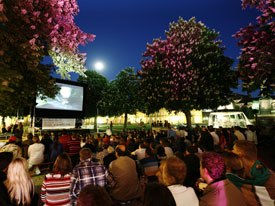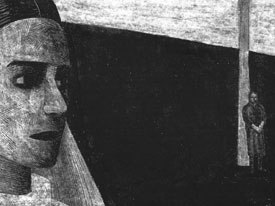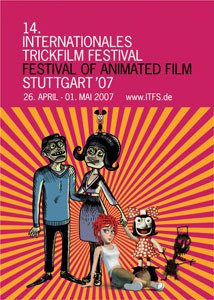Sabrina Schmid travels to Stuttgart for the Festival of Animated Film to report her impressions about the animations, the filmmakers, the events and the atmosphere.

The Festival of Animated Film Stuttgart (Germany, April 26 -May 1, 2007) is one of the largest and main international competitive animation festivals on the global animation circuit.
I revisited the festival this year to report my impressions about the animations, the filmmakers, the events and the atmosphere. This year, one couldn't help commenting upon the weather, as well as the films!
Everyone seemed elated by the high summer temperatures, sunshine and everlasting pale-blue skies with no hint of clouds. Wonderfully animated films, great animators and guests, workshops, food, drink, discussion, parties: all these elements combined alchemically with the fantastic weather to create an especially vibrant atmosphere and joyful mood.
The scene was set for a summer feast of animation. It all takes place in the picturesque inner-city setting of Stuttgart. Five main cinema venues located very centrally allow animation enthusiasts to venture right into the heart of the city. Everything connected to the festival is within short walking distance. Just a two-minute walk from the cinemas we find the Festival Lounge which hosts guests and professionals with brunches, filmmaker talks, official functions as well as impromptu parties after the late-night programs.
From there we also have a direct view of the large outdoor screen and nightly Open Air animation. Aptly named the Festival Garden, this setting adjoins a main square flanked by a castle and a museum. During the day, people sit on the grass lawns and catch some sun. Every evening, the free shows of concerts and animation outdoors in this festive and social atmosphere of music, food, drink and films, introduces the animation to a general public who might otherwise never have gone to see them.

The complete festival offers a very wide range of programs with a great diversity of films to see. This year, Stuttgart had attracted more than 1600 submissions of animations and the various programs screened more than 500 films from more than 40 countries. These range from animation shorts in the main "International Competition," the "Young Animation" or student competition, animated feature films, animated series, to supporting animation programs selected for the "Best of Animation" and "Panorama" sessions, as well as the "Tricks for Kids" show with a workshop for children to create their own animations. Plus, there are professional workshops, schools and studio presentations, and a range of special interest programs, for example, films from the Cartoon d'Or and Prix Ars Electronica, amongst others.
International Competition
The main international competitions screen to a full house each evening as the 560 seated cinema is filled to absolute capacity with some extra standing room. The main competition is then repeated while the student competition also fills the cinema next door. It's pertinent to note the popularity of these screenings, not just as a reflection on the festival's amazing success in terms of audience, but also on the extraordinary inventiveness of animation as a powerful visual medium of communication that makes audiences receptive to it. It indicates that there is a wider audience interested in the artistic animation film and more unusual works, such as shown in the competitions. This is a credit to the overall programming strategy, as well as to the selection of films at Stuttgart.
Any filmmakers who have shown their animation films at a festival will know that a full cinema generates a tangible sense of excitement and anticipation. A responsive audience is important for the works and to their filmmakers and may be a reward in itself. But significantly, festivals such as Stuttgart provide necessary distribution opportunities for short animations and independent features as well as networking mechanisms for the filmmakers and other animation industry professionals.
In the cinema setting, watching the animated films becomes a social experience, continuing beyond the screenings in discussions, conversations and later reflections, providing an abundance of things to communicate to others. A few highlights from the competition programs were:
Suzan Pitt's animation El Doctor (USA, 2006, 24 min.) is a surrealist tale where atmospheric painted backgrounds lend a sumptuous edge to the setting of a crumbling Mexican hospital. We discover an absurdist and intriguing view of life, death and miracles through the tormented eyes of a drunken doctor, conveyed with a bizarre sense of melancholy and humor.
Florence Miailhe's animation Conte de Quartier (France/Canada, 2006, 15:36 min.) uses mixed animation techniques ranging from drawings, cutouts and frame-by-frame painting, creating painterly, ever-changing and surprising images. It tells a tangled adventure of a woman, a leopard, a dog, a boy, a doll and a treasure box, in a fantastical city setting.

Andreas Hykade's animation, The Runt (Germany, 2006, 10 min.), is a powerful tale of a boy and his pet blue rabbit, "Wanna eat them gotta kill them!" It explores the human condition of being a carnivore, simplified in story and visuals to its violent essence by stylized drawings and use of primary emotive colors. The film forms the third of a triptych of Hykade's short animations, which are currently showing at a retrospective of his films at the Museum of Modern Art in New York.
Eva M. Toth's animation Laika's Memory (Hungary, 2005, 4 min.) is one of the few non-figurative abstract films in the programs, being animated improvisations using calligraphic lines, marks and patterns, which are animated to minimalist music.
Pauline Pinson's Aided Migration (France, 2006, 4:33 min.) is a humorous take on migration where we find an assortment of migratory birds traveling to their new summer locations in an airplane, and the film uses traditional cel animation with a stylized cartoon look. This animation won the SWR Audience Award.
Vladimir Leschiov's Lost in Snow (Latvia, 2007, 7:50 min.) is a nicely paced and constructed animation about being lost on drifting ice and fishing. It portrays a sense of human hopelessness in a philosophical way.
Michaela Pavlatova's Carnival of Animals (Czech Republic, 2006, 12 min.) is an unusually striking animation described as an animated musical erotic fantasy. It explores variations on the theme from male and female perspectives set to the wonderful music of Camille Saint-Saens. It uses cel animation techniques with the look of colorful pastel drawings in varied visual styles.
Adriaan Lokman's Forecast (The Netherlands, 2006, 10 min.) is a mesmerizing computer animation taking one on a journey into a beautiful world of clouds, which transform in a myriad of multicolored and mysterious ways. It's great to see on a large cinema screen, yet one would like to be completely immersed in this supernatural atmosphere. Everyone sees it slightly differently.
Jeu (Switzerland/Canada, 2006, 3:51min.) by the animation master George Schwizgebel explores shapes, figures and movement around sound. It's described as a visual and musical game, which expands and contracts to the rhythm of the Scherzo from Serge Prokofiev's Concerto No. 2, and the animation reverses at the end as the soundtrack rewinds.

Grand Prix
This year, the festival's prestigious Grand Prix was awarded to La memoria dei cani (The Memories of Dogs), 8 min., Italy/France 2006, directed and produced by the animator Simone Massi.
The film utilizes animated drawing on paper in black and white, where areas of cross-hatching lend texture, as well as a nervous animated energy. Strong compositions with contrasting fields of light and dark initially lead us through a landscape with a dog toward a farmhouse and into its interior, as if seen through memory. There is a subtle ambiguity between images used as metaphor or narrative, which makes the telling of the story dreamlike. Via the movement and progression through the landscape and time, the boy's painful experience is re-lived.
The jury statement reads, "With minimalistic means this film poetically deals with human suffering and dignity, together with high-level design and artistic intensity. The jury wishes that the filmmaker will continue his artistic development and make more beautiful films."
Massi studied animated cinema at the famous Urbino Fine Arts School, which is established since more than 100 years and has an animation department since about 50 years. The filmmaker has previously created 15 short animated films that have been exhibited in one-man shows in Europe and have won several awards. After screening La Memoria dei cani at the Hiroshima international animation festival, the Stuttgart Grand Prix is the first award for this film.
At the closing night filmmakers party, well after midnight at the Festival Lounge, finally it's possible to ask the main winner directly, how does he feel about receiving the Grand Prix? Massi says emphatically that "It's such a great compliment," particularly in the context of the other films in competition, which are very good, and he adds, especially in the context of the jury members whom he greatly admires. The filmmaker says that the award is very important for him not just in terms of money but also to become known and to find a producer for his next animation.
Flashback to the day before. I had the opportunity to talk to the well known animation director Regina Pessoa (Porto, Portugal) a member of the Jury for the international competition. Her animation work has won the Grand Prix Award at Annecy 2006, was nominated for the Cartoon d'Or and short-listed for the Oscar nominations, amongst winning more than 30 other international awards.

While we're sitting in the blazing noon sunshine, over mineral water and coffee, I'm interested to find out her views about the Stuttgart Festival and the awards, in particular its main prize. She considers that in its selection for the competition, Stuttgart chooses the more artistically orientated animations than other festivals generally do -- which is a good thing, she adds, and more to her own aesthetic taste and direction. In terms of the awards and prizes at the Stuttgart Festival, there were at least 10 films in the international competition that the jury considered very good in different ways and on the same level, but only one could win. In this context, the important criterion for the international jury was to consider how an award would benefit the filmmaker.
She points out that the animation world is a small community, and considering what a director may do next in their work and development is very important. By this consideration, an agreement was easily reached by the jury. Pessoa regards the winning animation as, "a wonderful film, artistically strong."
Change of location, and to the festival Café le Theatre. Here I could talk to the renowned animation critic and historian Giannalberto Bendazzi (Milan, Italy) who is also member of the Jury for the international competition. He is professor of history of animation at the Università degli Studi di Milano, and author of the book, Cartoons, 100 Years of Cinema.
He describes the Festival of Animated Film Stuttgart as, "one of the great animation festivals in the world!" His regard for the festival is echoed by his appreciation of the high standard of the competition films this year, and he suggests that at least 15 films would be deserving of prizes, or even more. Each film conveys a particular quality, while the themes and subjects of the animations differ greatly. One "never can compare quality with quality" he explains, as distinct from merely a personal reaction of liking or disliking something. Actually, he would have been happy with 10 prizes!

However, it was not difficult to reach a decision for the main winner, because the jury was harmonious and shared the same philosophical viewpoints. Bendazzi felt that the winning animation is, "extremely sincere so you feel that there is a real inspiration and a real human being behind it." A particular quality is that the film "doesn't try to please you, it tries to tell you something."
Are there any particular trends evident in animation currently? Bendazzi doesn't believe so, but observes that the general state of health of "high level animation" in the context of the independent festivals or "high culture" animation (distinct from popular culture) is very good at the moment; in fact, he considers that since the 1960s when the first animation festival was established in France, independent animation, at the moment, is flourishing worldwide.
The 14th Trickfilm Festival Turns 25 Years
Established as one of the largest animation festivals in the world, the Festival of Animated Film Stuttgart, turned annual in its 14th edition. Actually, it has also turned 25 years!
To gain an understanding about the festival's background and development I have the opportunity to chat with Ulrich Wegenast, the festival's artistic director since 1996 and designer of the film programming.
This animation festival started 25 years ago in the 1980s as a small festival of student films and shorts, in just one cinema. This aspect is still evident by the importance of the student films in competition and the strong link to the Film Academy Baden-Württemberg in the region. The focus on the artistic animated film (as animation for adults, not just for kids) and the student animations in the main competitions provides the nucleus for the festival, Wegenast explains: "Also in terms of audience," as the competition programs are actually the best attended screenings.
The starting point for the animation festival since its beginning, is "the artistic animated film" or der künstlerische Animationsfilm. This has contributed to the festival's success, both critically and in audience terms. The budget for the festival is now in the upper range of a six-figure Euro amount, indicated Dittmar Lumpp, the festival's managing director.

An increase in animation production worldwide seems evident by the increased entries of films to the festival each year. As apparent by the diverse range of animations, the festival's aim is to widen its programs even further to represent animation a whole: shorts, student, more features, tricks for kids, as well as animated series and applied animation, and to reach new audiences.
The festival is also developing a project and business platform, to initiate new content and projects in animation. For example, the Film & Media Festival Association also runs other events, such as the German Corporate Film Award, the Short Film Documentary Conference, and the Short Film Biennale in Ludwigsburg, and produces a "Best of Animation" program, which tours to different regions and other cities, making the festival visible throughout the year. The aims have indeed become all encompassing. The cooperation between the festival and the fmx is very important, facilitating communication and exchange for the industry and professionals on a much larger scale than previously possible.
Festivals are mainly about networking, says Wegenast, and also for politicians and the audience to see that there is a worldwide culture, where globalization also means an exchange of ideas and aesthetics, not just a commercial exchange, and on a higher level it means, "an understanding of each other; it's a humanistic approach."
Are there any particular trends evident in animation currently? Wegenast considers that over the last five years or so there has been a hybridization of animation where different aesthetics merge; there is no longer a strict ideology about computer animation; it's becoming very organic where animators can concentrate on the artistic/aesthetic and narrative/storytelling aspects; yet through the contemporary technology and processes animation allows for a quicker reaction, to create films faster or on the spot, and there is the increased necessity for greater interaction not only in the business sense but in knowledge transfer.
The "48-H-3D-Jam" Live Competition
Saturday night. So much animation makes it difficult to see everything, well, almost impossible! As well, there are six teams of animation students competing to create 30-second animations in 3D CGI, within 48 hours, set up and working in an area open to the public and festival visitors. Close to midnight on Saturday, with just 12 hours to their deadline, I venture to interview the competitors onsite and am lucky to catch some of their comments. "We will be working through all night!" explain Kathrin Desch & Elahe, the team from the Hochschule für Gestaltung, Offenbach (Germany.) Their determination is echoed by all the competitors and some teams are aiming for 90 seconds or more.
Meanwhile, Woijciech Hoffmann and Cezary Kwasny, the team from the Academy of Fine Arts Poznan (Poland) expresses great confidence, "We already have covered most of the project... " Their approach was to mix different kinds of animation, by also recording video footage outdoors on location in Stuttgart "... of people, trees and buildings ... " and mixing it with their animation and the 3D Red Girl character. Their film Negative, combining different imagery and techniques, finally produced within the 48 hours went on to win the 48-H-3D-Jam Red Girl Session presented at the Young Animation Party on the following night.

Schools Presentations and "Young Animation"
Also of great interest at the festival were the international "School Presentations" programs showing student productions presented by teachers and students from the courses with discussion about their programs, content and approaches. This year's selection included the well known HFF "Konrad Wolf" Potsdam-Babelsberg (Germany) St. Joost Academy, Breda (The Netherlands) the Filmakademie Baden-Württemberg (Germany) and the Bezalel Academy of Arts and Design, Jerusalem (Israel).
The overall high standard of all the student animation is well reflected by the student films also selected for the main international competitions, including this year's winner of the "Young Animation" award, Beton, 6 min., Bezalel Academy auf Arts and Design, Jerusalem, Israel 2006, by Ariel Belinco and Michael Faust. The jury statement says: "We noticed the generally high standards of technical achievement of the animation schools. At the same time we wanted to draw the attention on the personal commitment of the authors. So we choose the film that succeeded to portray a delicate political situation with emotional involvement revealing human stupidity in a warm and humorous way." The animation shows a group of soldiers' various attempts to obliterate a kite flying in the sky.
Workshops and Studios
Then there were also the filmmaker workshops by luminary animators, providing valuable insight to the work, techniques and creative processes of individual animation directors, namely Regina Pessoa, Bill Plympton, Raimund Krumme and Mikhail Aldashin.
As well as the workshops, the major studio presentations were of great popularity. In a more mainstream context, this included presentations by Aardman Animation productions, by Sony Pictures Imageworks presenting 15 years of digital imagery and animation, and Buena Vista's special preview of the new Pixar animation, Ratatouille. This was particularly interesting as preview excerpts were shown from the feature animation, including in-production sequences that had not been shown elsewhere.
Just as there are more animated films in the shorts competitions possibly deserving of prizes, there are many more wonderful animations seen at this festival that are worthy of comment or review than I can write about. For passionate animation enthusiasts, visit the festival and also try the festival's Best of Animation DVD available from ITFS website. Next year, the 15th Festival of Animated Film Stuttgart is planned for May 1-6, 2008.
Awards of the 14th Stuttgart Festival of Animated Film/May 1, 2007
International Competition
Grand Prix -- State of Baden-Wuerttemberg & City of Stuttgart Grand Award for Animated Film with a cash prize of 15,000: La memoria dei cani (The Memories of Dogs), by Simone Massi, 8 min., Italy / France 2006
International Promotion Award for the best graduation film with a cash prize of 10,000: My Date From Hell, by Tim Weimann, Tom Bracht, 14 min, Filmakademie Baden-Württemberg, Germany 2006
SWR Audience Award, with a cash prize of 6,000: Migration assistée (Aided Migration), by Pauline Pinson, 4.33 min., France 2006
Young Animation
Award for the best student film with a cash prize of 2,500, sponsored by Landesanstalt für Kommunikation Baden-Wuerttemberg and MFG Filmförderung Baden-Wuerttemberg: Beton, by Ariel Belinco, Michael Faust, 6 min., Bezalel Academy auf Arts and Design, Jerusalem, Israel 2006
Special Mention: Elet Vonal (Life-Line), by Tomek Ducki, 6.40 min., Hungary 2006
Tricks for Kids
Award for the best children's animated film with a cash prize of 4,000, donated by NICK: Zhiharka, by Oleg Uzhinov, 13.11 min., Russia 2006
Special Mention: Ernst im Herbst, by Jakob Schuh, Michael Sieber, 6.30 min, Germany 2006
AniMovie
Award for the best animated feature film with a cash prize of 2,500, donated by Leonhardt & Kern Werbung GmbH: Azur et Asmar, by Michel Ocelot, 93 min., Frankreich / France 2006
Animated Series
Award for the best TV animated series with a cash prize of 2,500, donated by EM. Entertainment GmbH: Little Princess: I Want My Snail, by Edward Foster, 11 min., Great Britain 2006
Special Mention: SpongeBob SquarePants: "Dunces and Dragons," by Vincent Waller, 22 min., USA 2005
48H-3D-Jam Red Girl Session
Winner: Negative, which was produced in 48 hours at the 14. Stuttgart Festival of Animated Film by Cezary Kwasny und Wojciech Hoffmann, Academy of Fine Arts Poznan, Poland
German Animation Screenplay Award
The German Animation Screenplay Award, donated by the Evangelical Church in Germany, to the value of 5,000: Sing, Hase, sing! (Sing Rabbit Sing!)by writer Heike Sperling and producer/writer Oliver Huzly, Berlin
Sabrina Schmid holds a BA and post graduate diploma in fine art painting and a graduate diploma in applied film and television in animated film. She made award-winning animated films (Australia) that screened at international festivals, including Ann Arbor, Annecy, Hiroshima, Stuttgart and Sydney. Since 2001, she is senior lecturer in animation at the University of Teesside, U.K., where she curated animations for the Animex 2005 festival. Her own recent animation showed at the AV-fest in Newcastle, and she also writes for the magazine Imagine, U.K.







